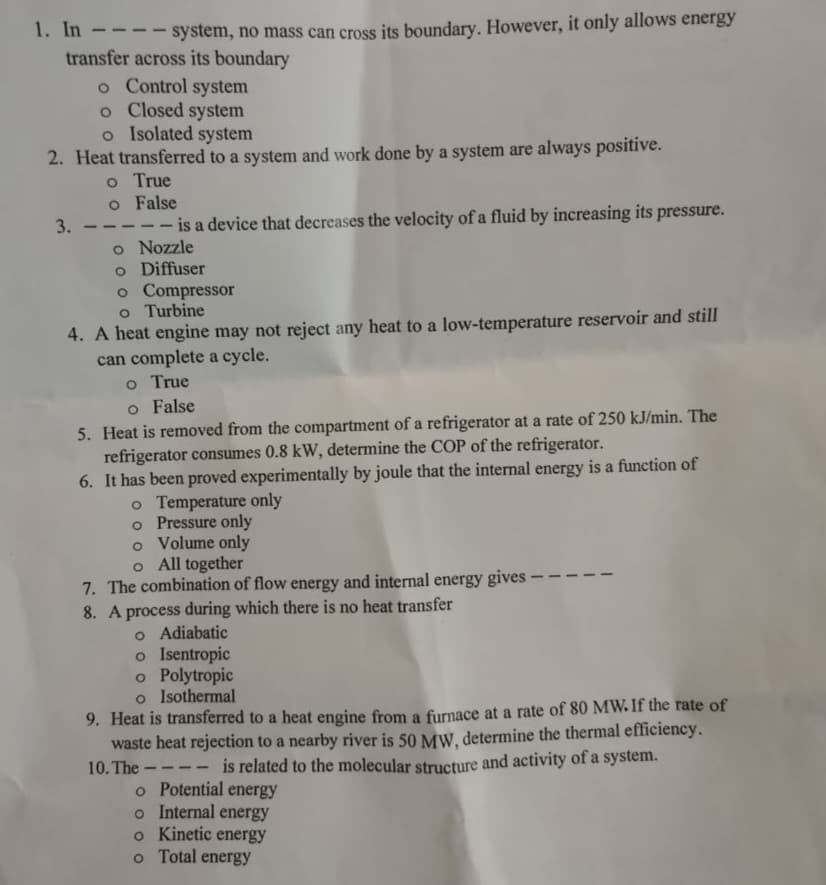1. In system, no mass can cross its boundary. However, it only allows energy transfer across its boundary ———- o Control system o Closed system o Isolated system 2. Heat transferred to a system and work done by a system are always positive. o True o False 3. - is a device that decreases the velocity of a fluid by increasing its pressure. o Nozzle o Diffuser o Compressor o Turbine temperature reservoir and still
1. In system, no mass can cross its boundary. However, it only allows energy transfer across its boundary ———- o Control system o Closed system o Isolated system 2. Heat transferred to a system and work done by a system are always positive. o True o False 3. - is a device that decreases the velocity of a fluid by increasing its pressure. o Nozzle o Diffuser o Compressor o Turbine temperature reservoir and still
Principles of Heat Transfer (Activate Learning with these NEW titles from Engineering!)
8th Edition
ISBN:9781305387102
Author:Kreith, Frank; Manglik, Raj M.
Publisher:Kreith, Frank; Manglik, Raj M.
Chapter6: Forced Convection Over Exterior Surfaces
Section: Chapter Questions
Problem 6.8P
Related questions
Question

Transcribed Image Text:1. In
system, no mass can cross its boundary. However, it only allows energy
transfer across its boundary
o Control system
o Closed system
o Isolated system
2. Heat transferred to a system and work done by a system are always positive.
o True
o False
3.
——
is a device that decreases the velocity of a fluid by increasing its pressure.
o Nozzle
o Diffuser
o Compressor
o Turbine
4. A heat engine may not reject any heat to a low-temperature reservoir and still
can complete a cycle.
o True
o False
5. Heat is removed from the compartment of a refrigerator at a rate of 250 kJ/min. The
refrigerator consumes 0.8 kW, determine the COP of the refrigerator.
6. It has been proved experimentally by joule that the internal energy is a function of
o Temperature only
o Pressure only
o Volume only
o All together
7. The combination of flow energy and internal energy gives -
8. A process during which there is no heat transfer
o Adiabatic
o Isentropic
o Polytropic
o Isothermal
9. Heat is transferred to a heat engine from a furnace at a rate of 80 MW. If the rate of
waste heat rejection to a nearby river is 50 MW, determine the thermal efficiency.
10. The-
is related to the molecular structure and activity of a system.
o Potential energy
o Internal energy
o Kinetic energy
o Total energy
Expert Solution
This question has been solved!
Explore an expertly crafted, step-by-step solution for a thorough understanding of key concepts.
Step by step
Solved in 2 steps with 2 images

Knowledge Booster
Learn more about
Need a deep-dive on the concept behind this application? Look no further. Learn more about this topic, mechanical-engineering and related others by exploring similar questions and additional content below.Recommended textbooks for you

Principles of Heat Transfer (Activate Learning wi…
Mechanical Engineering
ISBN:
9781305387102
Author:
Kreith, Frank; Manglik, Raj M.
Publisher:
Cengage Learning

Principles of Heat Transfer (Activate Learning wi…
Mechanical Engineering
ISBN:
9781305387102
Author:
Kreith, Frank; Manglik, Raj M.
Publisher:
Cengage Learning